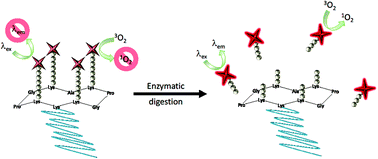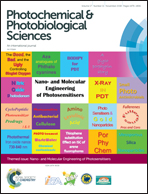Cyclopeptidic photosensitizer prodrugs as proteolytically triggered drug delivery systems of pheophorbide A: part I – self-quenched prodrugs†
Abstract
Herein, we report the synthesis of a new prodrug system consisting of regioselectively addressable functionalized templates bearing multiple pheophorbide A moieties for use in photodynamic therapy. These coupling reactions were achieved using copper-free “click” chemistry, namely a strain-promoted azide–alkyne cycloaddition. This new design was used to obtain well-defined quenched photosensitizer prodrugs with perfect knowledge of the number and position of loaded photosensitizers, providing structures bearing up to six photosentitizers and two PEG chains. These conjugates are ideally quenched in their native state regarding their fluorescence emission (up to 155 ± 28 times less fluorescent for an hexasubstituted conjugate than a monosubstituted non-quenched reference compound) or singlet oxygen production (decreased 8.7-fold in the best case) when excited. After 2 h of proteolytic activation, the fluorescence emission of a tetrasubstituted conjugate was increased 17-fold compared with the initial fluorescence emission.

- This article is part of the themed collection: Nano- and Molecular Engineering of Photosensitisers


 Please wait while we load your content...
Please wait while we load your content...